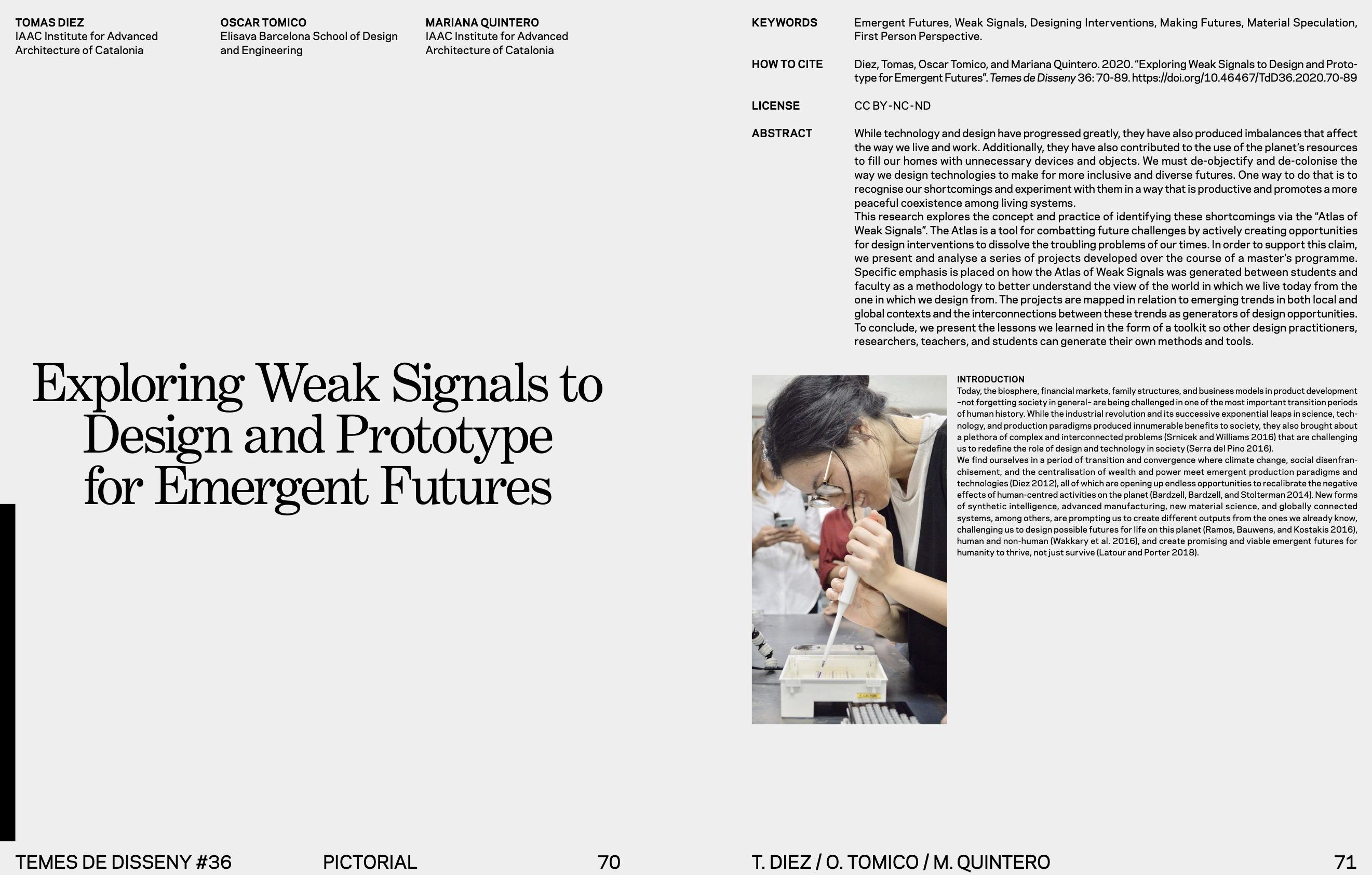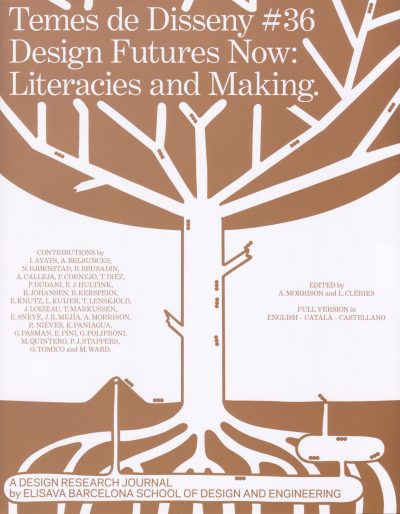While technology and design have progressed greatly, they have also produced imbalances that affect the way we live and work. Additionally, they have also contributed to the use of the planet’s resources to fill our homes with unnecessary devices and objects. We must de-objectify and de-colonise the way we design technologies to make for more inclusive and diverse futures. One way to do that is to recognise our shortcomings and experiment with them in a way that is productive and promotes a more peaceful coexistence among living systems.
Design for emergent futures
Design can give us the power to shape the environment and the imagination to create a desired future reality (Dunne and Raby 2013; Schultz 2015; Blythe 2014). However, one of the challenges for designers today is how to embrace non-linear strategies in a world of complexity and chaos. Designing emergent futures means de-objectifying and de-colonising design to focus on designing interventions in the present from a 1st person perspective (Tomico, Winthagen, and Heist 2012) and to create new narratives about possible, desirable futures that we cannot anticipate – but which we can intimately play with and learn from (Søndergaard and Koefoed 2018).
In order to exemplify this approach, we present and analyze a series of projects developed over the course of the Master’s in Design for Emergent Futures (Diez and Tomico 2020). Through the lens of critical and speculative design and technological exploration, students expand the focus of their interests and acquire the skills to turn protests into prototypes (Malpass 2019) and ideas into actions, and by harnessing the potential of digital fabrication, artificial intelligence, synthetic biology and blockchain, students are able scale up the impact of their actions to address systemic challenges of our current socio-economic paradigms (Hand et al. 2010). The program’s focus is on the design of personal interventions in the real world (Desjardins and Wakkary 2016) in the form of products, platforms and other deployments based on present weak signals in order to explore new emergent futures.

Cover pages of the pictorial “Exploring Weak Signals to Design and Prototype for Emergent Futures”, by Tomas Diez, Oscar Tomico and Mariana Quintero. https://doi.org/10.46467/TdD36.2020.70-89
The paper attached explores the concept and practice of identifying these shortcomings via the “Atlas of Weak Signals.” The Atlas is a tool for combatting future challenges by actively creating opportunities for design interventions to dissolve the troubling problems of our times. In order to support this claim, we present and analyze a series of projects developed over the course of a master’s program. Specific emphasis is placed on how the Atlas of Weak Signals was generated between students and faculty as a methodology to better understand the view of the world in which we live today from the one in which we design from. The projects are mapped in relation to emerging trends in both local and global contexts and the interconnections between these trends as generators of design opportunities. To conclude, it presents the lessons we learned in the form of a toolkit so other design practitioners, researchers, teachers and students can generate their own methods and tools.
This paper was part of the special issue of Temes de Disseny #36, Design Futures Now: Literacies and Making. The issue presents the challenge of framing design’s role in futures making through a series of contemporary scientific works. Design Futures is a discipline with its own literacies and making methodologies, and aims to address the world’s complexity and phenomena by delivering options and opportunities for alternative presents.
You can explore the full issue following this link.

Cover of Temes de Disseny #36, Design Futures Now: Literacies and Making. Guest Editors: Andrew Morrison and Laura Clèries. http://tdd.elisava.net
Blythe, Mark. 2014. “Research through Design Fiction: narrative in real and imaginary abstracts.” In CHI 14: Proceedings of the SIGCHI Conference on Human Factors in Computing Systems, 703-712. New York: ACM. https://doi.org/10.1145/2556288.2557098
Desjardins, Audrey, and Ron Wakkary. 2016. “Living In A Prototype: a Reconfigured Space.” In Proceedings of the 2016 CHI Conference on Human Factors in Computing Systems, 5274-5285. New York: ACM. https://doi.org/10.1145/2858036.2858261
Diez, Tomas, and Oscar Tomico. 2020. “The Master in Design for emergent futures.” IAAC. https://iaac.net/educational-programmes/masters-programmes/master-in-design-for-emergent-futures-mdef/.
Dunne, Anthony, and Fiona Raby. 2013. Speculative Everything: Design, Fiction, and Social Dreaming. Cambridge, Mass.: MIT Press.
Hand, Chris, Anab Jain, Tessy Britton, Graham Burnett, Darryl Chen, Christopher Collett, Sanjiv Sharma, Charlie Tims, and Liam Young. 2010. “The Power of 8: Encouraging Collaborative DIY Futures”. In Proceedings of the 6th Swiss Design Network Conference: Negotiating Futures – Design Fiction, 194-205. Basel: Swiss Design Network.
Malpass, Matthew. 2019. Critical Design in Context: History, Theory, and Practices. London: Bloomsbury Academic.
Schultz, Wendy L. 2015. “A Brief History of Futures.” World Futures Review 7(4): 324–331. https://doi.org/10.1177/1946756715627646
Søndergaard, Marie Louise Juul, and Lone Koefoed Hansen. 2018. “Intimate Futures: Staying with the Trouble of Digital Personal Assistants through Design Fiction”. In DIS ’18: Proceedings of the Designing Interactive Systems Conference, 869–880. New York: ACM. https://doi.org/10.1145/3196709.3196766
Tomico, Oscar, Vera Winthagen and Marcel van Heist. 2012. “Designing for, with or within: 1st, 2nd and 3rd person points of view on designing for systems.” In NordiCHI ’12: Proceedings of the 7th Nordic Conference on Human-Computer Interaction, 180–188. New York: ACM.
Text by Oscar Tomico, Tomas Diez and Mariana Quintero.
Full article available at: https://doi.org/10.46467/TdD36.2020.70-89